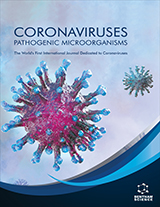Abstract
The sodium-iodide symporter (NIS) is an intrinsic plasma membrane protein that mediates active transport of iodide in the thyroid gland and several other extra-thyroidal tissues. This activity has been utilized for many years for imaging the thyroid gland and for treatment of thyroid disease both benign and malignant. Cloning and characterization of NIS has more recently allowed research into its use in nonthyroidal cancers through gene transfer for both diagnosis and treatment.
Keywords: sodium-iodide symporter, gene therapy, thyroid neoplasms
Current Drug Targets - Immune, Endocrine & Metabolic Disorders
Title: The Sodium-Iodide Symporter
Volume: 4 Issue: 3
Author(s): C. H. Baker and J. C. Morris
Affiliation:
Keywords: sodium-iodide symporter, gene therapy, thyroid neoplasms
Abstract: The sodium-iodide symporter (NIS) is an intrinsic plasma membrane protein that mediates active transport of iodide in the thyroid gland and several other extra-thyroidal tissues. This activity has been utilized for many years for imaging the thyroid gland and for treatment of thyroid disease both benign and malignant. Cloning and characterization of NIS has more recently allowed research into its use in nonthyroidal cancers through gene transfer for both diagnosis and treatment.
Export Options
About this article
Cite this article as:
Baker H. C. and Morris C. J., The Sodium-Iodide Symporter, Current Drug Targets - Immune, Endocrine & Metabolic Disorders 2004; 4 (3) . https://dx.doi.org/10.2174/1568005310404030167
| DOI https://dx.doi.org/10.2174/1568005310404030167 |
Print ISSN 1568-0088 |
| Publisher Name Bentham Science Publisher |
Online ISSN 1875-5917 |
Related Articles
-
Histone Deacetylase Inhibitors as Potential Therapeutic Agents for the Treatment of Malignant Mesothelioma
Anti-Cancer Agents in Medicinal Chemistry Delivery of siRNA to the Target Cell Cytoplasm: Photochemical Internalization Facilitates Endosomal Escape and Improves Silencing Efficiency, In Vitro and In Vivo
Current Pharmaceutical Design Molecular Evidence of Compound Kushen Injection Against Lung Cancer: A Network Pharmacology-Based Investigation from Western Medicine to Traditional Medicine
Anti-Cancer Agents in Medicinal Chemistry Rexinoids for Prevention and Treatment of Cancer: Opportunities and Challenges
Current Topics in Medicinal Chemistry Role of Genetic Factors in the Pathogenesis of Radial Deficiencies in Humans
Current Genomics The PI3K-AKt-mTOR Pathway and New Tools to Prevent Acquired Hormone Resistance in Breast Cancer
Current Pharmaceutical Biotechnology Serum Amyloid Beta Peptides in Patients with Dementia and Age-Matched Non-Demented Controls as Detected by Surface-Enhanced Laser Desorption Ionisation-Time of Flight Mass Spectrometry (SELDI-TOF MS)
Current Clinical Pharmacology Fireflies in the Coalmine: Luciferase Technologies in Next-Generation Toxicity Testing
Combinatorial Chemistry & High Throughput Screening Idiopathic Transverse Myelitis and Neuromyelitis Optica: Clinical Profiles,Pathophysiology and Therapeutic Choices
Current Neuropharmacology Liver X Receptor: Crosstalk Node for the Signaling of Lipid Metabolism,Carbohydrate Metabolism, and Innate Immunity
Current Signal Transduction Therapy Molecular Dynamics, Density Functional Theory, Pharmacophore Modeling, Molecular Interaction Fields and ADME/Tox Investigation of Novel Bioactive Compounds Interacting with CDK2 Surfaces
Current Physical Chemistry Common Pathways in Health Benefit Properties of RSV in Cardiovascular Diseases, Cancers and Degenerative Pathologies
Current Pharmaceutical Biotechnology Interleukin-26, a Highly Cationic T-Cell Cytokine Targeting Epithelial Cells
Anti-Inflammatory & Anti-Allergy Agents in Medicinal Chemistry CEBP Epigenetic Dysregulation as a Drug Target for the Treatment of Hematologic and Gynecologic Malignancies
Current Drug Targets Nox Inhibitors & Therapies: Rational Design of Peptidic and Small Molecule Inhibitors
Current Pharmaceutical Design Breaking the DNA Damage Response via Serine/Threonine Kinase Inhibitors to Improve Cancer Treatment
Current Medicinal Chemistry Nitrogen-Containing Heterocycles as Anticancer Agents: An Overview
Anti-Cancer Agents in Medicinal Chemistry Measles Virus as An Oncolytic Vector Platform
Current Gene Therapy Withdrawal Notice: Drug Repurposing for Prospective Anti-Cancer Agents Along with the Clinical Status of the Repurposed Drug
Anti-Cancer Agents in Medicinal Chemistry Cigarette Smoking and Angiogenesis: What is the Role of Endothelial Progenitor Cells?
Current Angiogenesis (Discontinued)



















